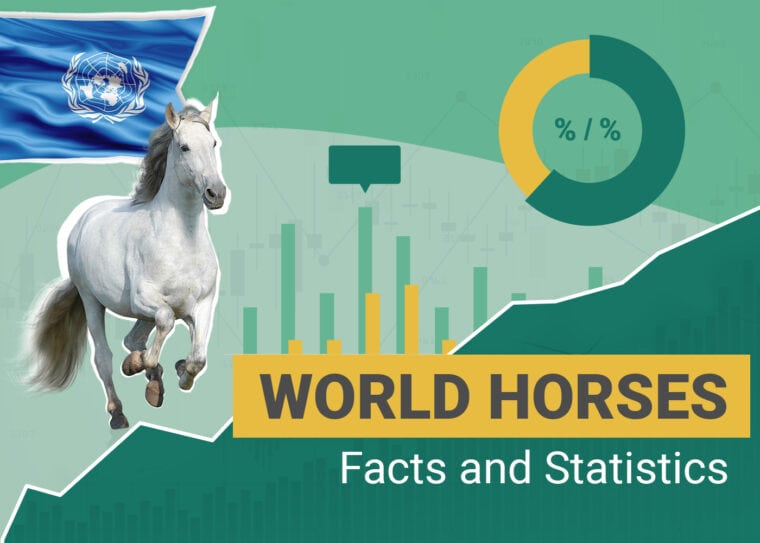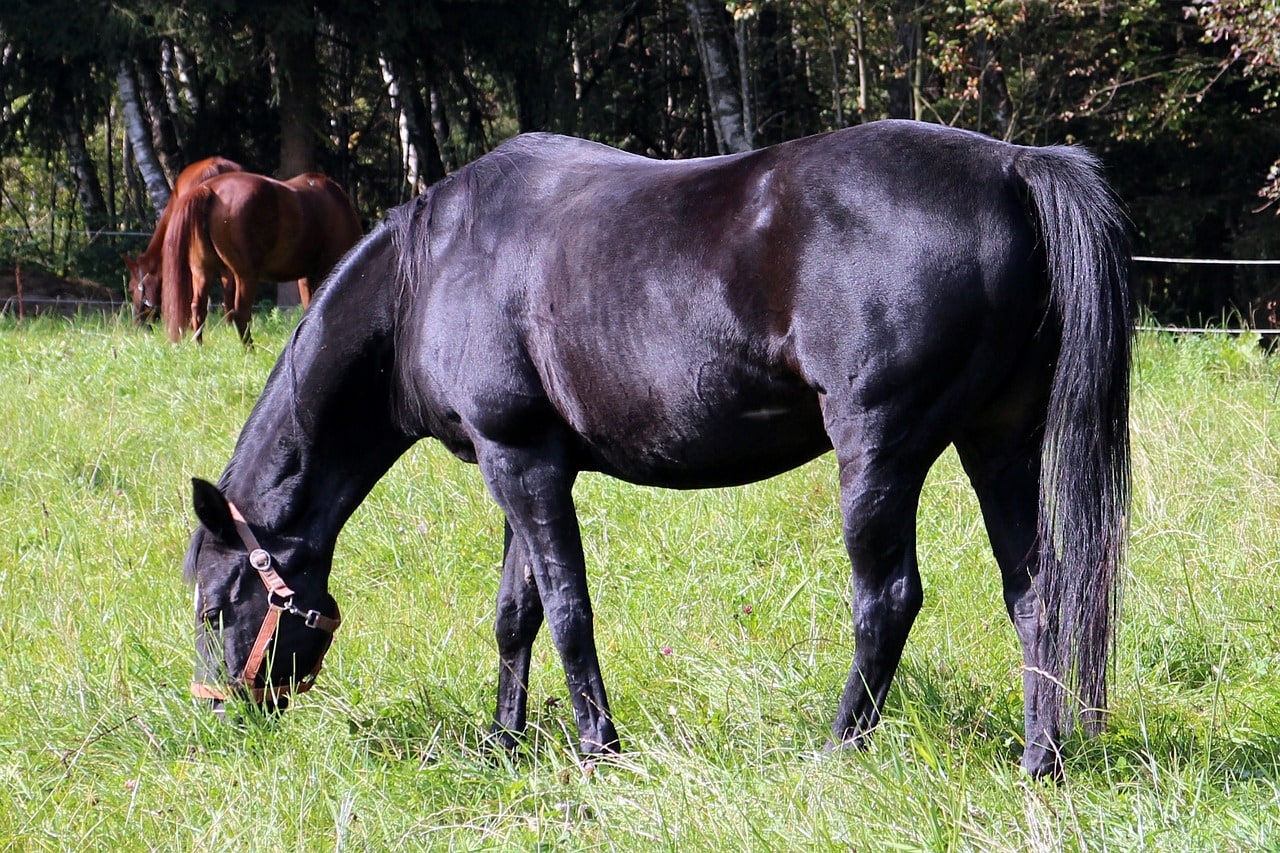
Click to Skip Ahead
Note: This article’s statistics come from third-party sources and do not represent the opinions of this website.
Horses are important parts of society. While most people don’t own horses, these graceful creatures are part of a prominent industry with significant economic impacts. There are around 7.2 million horses in the U.S. alone. If you’re curious about how much of an impact they have on the world, you’ve come to the right place! We outline statistics and answer your questions about how many horses there are, where they’re located, and how they’re used.
Top 10 Horse Statistics
- The U.S. horse population is estimated to be over 7.2 million horses.
- The wild horse population is estimated to be around 600,000.
- Texas has the highest horse population, with more than 1 million horses.
- There are about 83,000 wild horses in the U.S., living across 10 western states.
- There are approximately 350 recognized horse breeds.
- Thoroughbreds and Quarter Horses are the most popular U.S. horse breeds.
- The United Kingdom equestrian industry is responsible for over $11 billion a year in economic contributions.
- The United Kingdom is home to approximately 850,000 horses.
- Romania has around 447,000 horses.
- The island of Grenada is home to approximately 30 horses.

Horse Population Statistics
1. The U.S. horse population is estimated to be over 7.2 million horses.
(Data Paddock)
These numbers are from 2016 because they are based on periodic farm surveys, and the U.S. Department of Agriculture only conducts a census every 5 years. While there was one conducted in 2021, those results are not yet available. The American Horse Council Foundation estimates the current number to be closer to 9.2 million.
There are approximately 2 million horse owners and a total of 7.1 million Americans involved in the horse industry

2. The wild horse population is estimated to be around 600,000.
(Spayvac)
It’s important to note that there is no global consensus on the exact number of wild horses. There are only published estimates, and they may not all be accurate. Some countries like the United States, Canada, and Australia publish annual data regarding their wild horse populations. Many European countries only publish data every few years, so the most recent numbers are estimated between 2015 and 2018.
While we can’t vouch for the current accuracy of the data, here is the breakdown, which gives a rough idea of the distribution of wild horses around the globe:
The rapidly growing wild horse population has a significant environmental impact on sensitive ecosystems. The U.S. and Australia have both developed programs aimed at population control — in some cases, resorting to culling the herds. Most government agencies agree that if possible, euthanasia should be avoided as a means of population control. Many wild horses have been removed from rangelands and relocated to farms, but the cost of these re-location efforts is extensive.
3. Texas has the highest horse population, with more than 1 million horses.
(Texas A&M Agrilife Extension Service; California Department of Food and Agriculture)
The population of horses in Texas accounts for 15% of all horses nationwide. California follows in second place, with a horse population of 700,000. Horses play a crucial role in the economy of both Texas and California.
4. There are about 83,000 wild horses in the U.S., living across 10 western states.
(Bureau of Land Management; Smithsonian Institute)
The Bureau of Land Management of the U.S. Department of the Interior conducts annual population inventories to estimate the number of wild horses and burros. These animals roam across 53.8 million acres of public land, 42.4 acres of which are under the jurisdiction of the Bureau of Land Management. These areas are further divided into subsets called Herd Management Areas. The 1971 Wild Free-Roaming Horses and Burros Act ensures that these animals cannot be relocated to lands where they are not free-roaming.
Wild horse populations also live on the Atlantic coast and small islands that include the Sable, Shackleford, and Assateague Islands.
The U.S. wild horse population continues to grow, increasing at a rate of 15-20% per year. This means the population will double every 4 to 5 years. It’s important to note that these population numbers don’t include new foals from 2021 which could total between 14,000 and 18,000.
Breed-Specific Statistics
5. There are approximately 350 recognized horse breeds.
(Equine Helper)
There are also 100 recognized pony breeds. That said, there are approximately 1,400 different horse breeds that aren’t recognized by national registries but are distinctly different from those that are.
Horse breeding isn’t regulated or monitored, with the exception of tracking bloodlines on registered individuals. At a local level, people cross bloodlines and breeds to develop new horses on a daily basis.
Here’s an example: The American Paint Horse is a recognized breed with a national registry. The Paint Horse was originally the product of cross-breeding a Thoroughbred and an American Quarter Horse.

6. Thoroughbreds and Quarter Horses are the most popular U.S. horse breeds.
(Horse Racing Sense)
Other popular breeds include the Arabian, Morgan, American Paint Horse, Tennessee Walking Horse, and Mustang.
There are 2.1 million Quarter Horses in the United States. The origins of the American Quarter Horse date back to the mid-1600s. This horse is well-known for its ability to sprint, easily outrunning other breeds in spans under a quarter-mile. Quarter Horses excel at sharp, intricate maneuvers because they are compact and muscular. This makes them a favorite in rodeos, barrel racing, and cattle work.
Thoroughbreds are well-known for their speed and agility on the racetrack. The U.S. Thoroughbred population totals approximately 1.1 million. The United States isn’t unique in its love of Thoroughbreds; they’re among the most popular breeds in the world. While they’re well-known as racehorses, you can find Thoroughbred horses in many other riding events in both English and Western disciplines.
Worldwide Horse Population Statistics
7. The United Kingdom equestrian industry is responsible for over $11 billion a year in economic contributions.
(Equine Business Association)
The United Kingdom is home to serious equine expertise. These industry experts have raked in over $700 billion through equestrian sports coaching and training endeavors.
As the second-most-attended sport in the U.K., horse races draw in 7 million spectators a year and generate close to $5 billion.
There are 250,000 people employed within the horse industry and over 27 million people in Britain with interest in the market.

8. The United Kingdom is home to approximately 850,000 horses.
(MSD Animal Health)
While the U.K. horse industry is massive, its horse population is only about 850,000. It does, however, have the highest exportation value in the world. The number of horse-owning households is estimated to be 374,000.
The number of riders in the U.K. is increasing, and the upturn in riders is great news for equestrian businesses because they can continue to support a sizable market. This is also great news for other equestrian-related businesses, as sales for tack and feed are also increasing.
9. Romania has around 447,000 horses.
(Statista, Four Paws)
Approximately 3% of the Romanian population live under extremely poor conditions and still use horses and donkeys for transportation and agricultural purposes. These animals often live under harsh conditions and endure long working hours.
Unfortunately, since these horses are dependent on people living in poverty, their health and welfare also suffer. They often lack adequate veterinary care and nutrition and suffer from ailments because their keepers don’t have the resources to fully provide for their needs.
Several rescue organizations have started campaigns to help provide care for Romanian horses. These campaigns aim not to remove these horses from their homes but to help their owners provide for their health and welfare while allowing the horses to stay and maintain their lifestyle.
10. The island of Grenada is home to approximately 30 horses.
(Horsemart)
This works out to one horse for every 3,577 people. This is surprisingly few, given the popularity of horse racing in other Caribbean countries. The sport is a major money-maker with a huge following in Jamaica, Barbados, Trinidad and Tobago, Puerto Rico, the Dominican Republic, and Martinique.
Several large breeding farms are located in Jamaica, but most racehorses are bloodstock imported from the United States.
Horse racing used to be big business in Grenada too, although its boom was in the 1960s. The decline in the industry isn’t unique; it has followed the same trend as many other big businesses on the island. The few horses that remain are part of the tourism industry, offering island tours on horseback.

Frequently Asked Questions About Horses
How many different types of horses are there?
All horse breeds are classified into four main groups: Light Horses, Heavy Horses, Ponies, and Feral Horses.
What are interesting facts about horses?
Horses are fascinating creatures. Here are a few facts about horses that aren’t commonly known by those outside the industry.
(BC SPCA)

How fast can a horse run?
The average domestic horse is capable of galloping at a speed of about 30 mph (48 km/h), but there are a few horses who have been clocked at over 40 mph (64 km/h). 44 mph (70.8 km/h) is the fastest horse speed recognized by Guinness World Records.
(LiveScience)
What do horses eat?
Horses are herbivores, meaning their diet consists mainly of tough grasses. The large, flat teeth at the fronts of their mouths are designed to grab and rip grass out of the ground. They have relatively small stomachs in comparison to their body size and must eat small, frequent meals.
A healthy horse should consume between 1% to 2% of its body weight in grass or hay each day. This means that the average domestic horse consumes approximately 20 pounds of forage a day.
(LiveScience)

Do horses sleep standing up?
Yes, they do, but not all the time. Horses can sleep standing up by locking the stifle joint (the equivalent of the human knee) on one of their hind legs to hold them upright. They will occasionally alternate which leg is locked to prevent strain. As prey animals, horses need to be able to respond quickly in the presence of a predator, and sleeping upright allows them to do this.
That said, when they need deep sleep, horses still have to lie down, and they will do so periodically throughout the day and night. Horses generally sleep in short bouts over a 24-hour period rather than sleeping for a single long period as humans do.
(LiveScience)
How big are horses?
The typical height range of horses is between 2 feet, 6 inches (76 centimeters), and 5 feet, 9 inches (175 centimeters), tall. They weigh between 120 pounds (54 kilograms) and 2,200 pounds (1,000 kilograms). That said, it’s not unusual for horses to be over or under this range. Since hundreds of different horse breeds have been developed through selective breeding, there is a wide range of sizes, from miniatures to large draft breeds.
The tallest horse currently alive is a Belgian named Big Jake. He tops out at 82.8 inches, which is nearly 7 feet tall (210 centimeters). The tallest horse ever recorded was a Shire named Sampson. His height was recorded in 1850 as 7 feet, 2 inches tall (86.2 inches or 219 centimeters).
On the flip side, the shortest horse ever recorded was a miniature named Thumbelina. She measured at a mere 17.5 inches (44.5 centimeters) tall shortly before her death in 2018.
(Guinness Book of World Records, LiveScience)
Conclusion
The population of both domestic and wild horses doesn’t appear to be declining anytime soon. The horse industry is huge in the U.S., the U.K., and many other countries. Hopefully, we’ve helped to shed light on horses worldwide. These creatures have played an essential role in human lives for thousands of years, so hopefully, we can appreciate them for many more years to come.
- Related Read: UK Horse Statistics
Featured Image Credit: Alexia Khruscheva, Shutterstock








